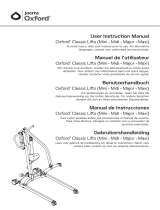
4 5
Mittelsäule des Stativs bzw. den Ausleger. Mit dem Klemmhebel (7) werden
diese Elemente aufeinandergedrückt und so gegen Verdrehen gesichert. Zu-
sätzlich erlaubt die Zahnung der Rosette in der Mitte, den Anstellwinkel des
Auslegers absolut verdrehsicher festzulegen. Ziehen Sie eine zweite Person
zur Montage hinzu.
Als Vorbereitung ziehen Sie die Mittelsäule des Stativs auf die notwendige
Höhe aus. Zur Montage des Klemmadapters am Stativ lösen Sie zunächst
den Klemmhebel (7) so weit, dass Sie die ersten beiden Elemente über die
Mittelsäule des Stativs stülpen können. Drehen Sie sich die beiden Elemente
so zurecht, dass die Mittelsäule in einer von der Größe passenden Ausspa-
rung ruht. Achten Sie darauf, auf beiden Seiten die Aussparung gleicher
Größe zu wählen, damit die Belastung gleich verteilt wird.
Halten Sie nun die Elemente, die die Mittelsäule des Stativs umschließen,
mit einer Hand geschlossen. Dies gibt Ihnen den Raum, den Ausleger auf
gleiche Weise in die anderen beiden Elemente einzulegen.
Drehen Sie nun den Klemmhebel (7) wieder so weit zu, dass sowohl das
Stativ als auch der Ausleger nicht mehr herausrutschen können.
Bewegen Sie nun den Klemmadapter auf die gewünschte Höhe. Drehen Sie
den Ausleger in den gewünschten Winkel und ziehen Sie ihn so weit aus wie
gewünscht. Lassen Sie hierbei genug Platz für das Gegengewicht. Achten Sie
darauf, dass die Zähne der Rosette im Klemmadapter ineinandergreifen und
einrasten können. Schrauben Sie nun den Klemmhebel ganz zu.
Der Ausleger ist nun montiert und wie gewünscht eingestellt.
Montage von Equipment am Ausleger
Der Ausleger ist ausziehbar und verfügt an der Spitze über einen 5/8“
Spigot-Adapter. An diesem können Sie Equipment aller Art befestigen.
Beachten Sie die maximale Belastbarkeit, siehe Technische Daten.
Um die Standfestigkeit des Stativs zu erhalten, liegt ein 4,4 kg schweres
Gegengewicht bei. Nutzen Sie dieses am hinteren Ende des Auslegers auf
der anderen Seite des Klemmadapters, um die Hebelwirkung des montierten
Equipments zu kompensieren. Ziehen Sie eine zweite Person zur Montage
hinzu.
Zur Montage von Equipment unter Einbeziehung des Gegengewichts be-
festigen Sie zuerst das Gegengewicht auf dem hinteren Ende des Auslegers
direkt an der Mittelsäule des Stativs, indem sie die Klemme öffnen, es auf-
setzen und die Klemme wieder anziehen. Ziehen Sie nun den Ausleger auf
die gewünschte Länge aus und befestigen Sie das gewünschte Equipment
abrutschsicher am 5/8“ Spigot, indem Sie darauf achten, die Schraube am
empfehlen wir eine breite Spreizung der Stativbeine. Vorsicht beim Arbeiten
mit den Stativbeinen, es besteht Klemmgefahr. Fixieren Sie die Stativbeine
durch das Festziehen der Stativbein-Verriegelungsschraube (5). Beachten
Sie, dass der untere Gummipuffer der Teleskopmittelsäule nicht den Boden
berühren darf, dies beeinträchtigt die Stabilität des Stativs. Verfahren Sie
beim Zusammenlegen des Stativs in umgekehrter Reihenfolge.
Höhenverstellung
Das Stativ verfügt über eine zweiteilige, ausziehbare Teleskopmittelsäule.
Mithilfe der Stativverschlüsse (4) arretieren Sie die Verschlussklemmen der
Mittelsäule (3). Lösen Sie zur Höheneinstellung des Statives die Stativ-
verschlüsse (4) durch ein Drehen gegen den Uhrzeigersinn. Vorsicht, die
Mittelsäulensegmente stehen unter Vorspannung und können herausschnel-
len! Stellen Sie die gewünschte Höhe ein und schließen Sie die Verschluss-
klemme wieder fest. Kontrollieren Sie abschließend durch ein Drücken der
Mittelsäulenelemente nach unten, ob sämtliche Verschlüsse korrekt xiert
sind. Das Stativ ist jetzt einsatzbereit.
Montage von Equipment auf dem Stativ
Am oberen Ende der Mittelsäule bendet sich ein Befestigungsadapter
(1). Dieser verfügt über einen als 16 mm Zapfen oder auch 5/8 Zoll Spigot
bekannten Anschluss.
Mithilfe dieses Adapters lassen sich Geräte wie Studioblitze, Leuchten,
Softboxen, Polestangen uvm. per genormter Halterung befestigen. Schrau-
ben Sie zur Befestigung Ihres Equipments die Arretierungsschraube der
Gerätehaltung Ihres zu befestigenden Zubehörs etwas heraus und führen Sie
die Gerätehalterung Ihres Equipments von oben in den Stativadapter (1) ein.
Ziehen Sie anschließend die Schraube wieder fest an. Achten Sie hierbei auf
die korrekte Positionierung der Halterung. Die Schraube muss am dünneren
Teil des Befestigungsadapters (1) festgeschraubt werden. Hierdurch wird
ein Lösen der Halterung inkl. Ihres Equipments zuverlässig verhindert. Auf
dem oberen Ende des Befestigungsadapters (1) ist zusätzlich ein 1/4 Zoll
Anschlussgewinde nutzbar. Auch hieran können Sie passendes Equipment
befestigen.
Montage des Auslegers am Stativ
Der Ausleger, bisweilen auch Galgen oder Boom genannt, wird mit Hilfe
eines Klemmadapters (2) am Stativ befestigt. Beachten Sie hierbei den
Aufbau: Der Klemmadapter besteht aus vier Elementen, die durch eine
Achse zusammengehalten werden. Jeweils zwei der Elemente umgreifen die
















